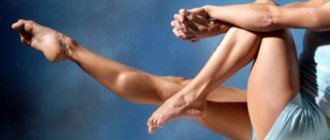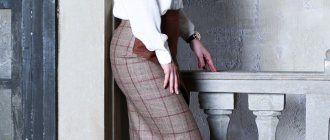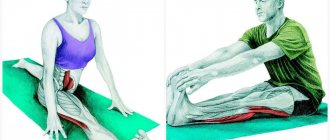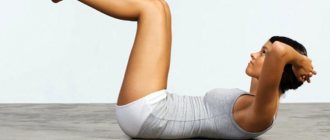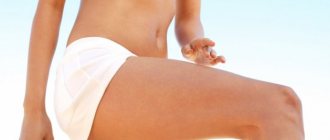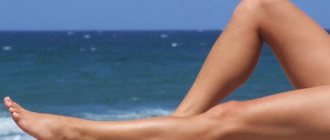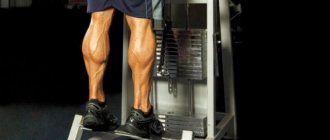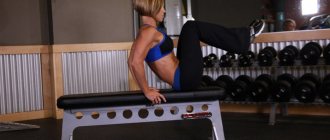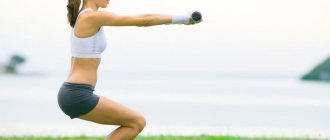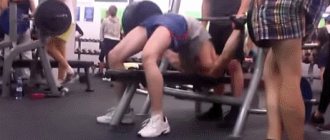Why are my calves full?
Women are in many ways inferior to men in terms of muscle corset and skeleton.
However, calves are a part of the body that can not only “catch up” in volume, but also exceed the representatives of the stronger half. Ideally, the girth of the calf should be equal to the girth of the biceps. If your proportion is far from ideal, and you want to know what to do to lose weight in your calves, let’s look at why they stand out so unattractively by their size. Causes of massive calves:
- Genetic predisposition. Take a close look at the calves of your female relatives. If they are massive, then it is likely that you will also experience such an unpleasant “transformation” over time. It's all about how long your ancestors' Achilles tendon was. If it is short, then the calf muscle will look more massive, and if it is long, then it will look slimmer. There's nothing you can do about genetics, but if you are aware of your predisposition, you can train properly to avoid overloading your boots and avoiding thickening of your boots.
- Sports activities. Fans of sports, ballroom dancing, football, running uphill and other exercises where the main load falls on the front arch of the foot may also be familiar with the problem of large calves. The muscles in this area become too massive, as they are worked more often during these activities.
- Fat deposits. Fat is deposited not only under the skin, but also among muscle tissue. Its excess can cause calves to increase in size and lose their elegance and beauty.
- Hormonal disbalance. High levels of the female hormone estrogen and low levels of the male hormone testosterone in the body cause fat to be unevenly distributed. Most of it accumulates in the area of the tops and thighs.
- Swelling of the lower extremities. Edema is a consequence of poor nutrition, alcohol abuse, a passive lifestyle and drinking insufficient amounts of water. Fluid tends to accumulate in the extremities, especially the lower ones. Your calves themselves may be slender and beautiful, but swelling leads to an increase in the volume of your legs.
- Walking in heels. Heel lovers should be aware that their favorite shoes have a dual effect on increasing calf size: the Achilles muscle becomes shorter due to constant wearing of stilettos, and all the other muscles in the lower legs are stressed and grow rapidly.
What to do if your calves seem full not because of excess weight
Some girls' calves seem too full, not because of excess weight, but because of swelling. In such a situation, the first thing you need to do is visit a doctor, who, after conducting an examination, will tell you what is causing the disease. Most often, to eliminate edema, a special diet is prescribed, which involves avoiding salt, fried and fatty foods, as well as taking diuretics. You cannot prescribe such medications for yourself; they must be selected by your attending physician, taking into account the individual characteristics of the body.
Following these recommendations will also help reduce the size of your calves:
- You should not wear tight or poor-quality shoes.
- It is forbidden to get drunk at night. At night, the elimination of fluid slows down, which is why it begins to accumulate in the tissues.
- If work takes place in an office, it is forbidden to sit on a chair or stool and tuck your lower limbs. This position leads to poor circulation, which may result in a slight increase in volume.
- If the reason lies in excessive training, you need to wisely select exercises that will not put stress on the calf muscles. Also, in such a situation, it is recommended to avoid long walks.
Dietetics for weight loss
Nutritionists give good advice on how to lose weight in your calves. Please note that not only the volume of the lower legs will decrease, but also the entire body. However, a balanced, healthy diet will only benefit you. Follow simple rules to actively remove excess fat.
Refusal of junk food
Eliminate sweets, white bread, pastries, sugar, soft wheat pasta, white rice, semolina and millet porridge, soda, and sweet juices from your diet. These products contain fast carbohydrates that immediately turn into fat. There is also a taboo on store-bought sauces, fatty meats, lard, and butter, as they contain a lot of unhealthy fats and cholesterol.
Smoked meats, pickles, marinades, sausages, pates and snacks are products that retain fluid in the body; they should not be on your menu.
Entering healthy products
Focus on healthy proteins: lean meat, fish, low-fat dairy and fermented milk products, nuts.
Also take care to provide your body with healthy unsaturated fats, they are found in vegetable oils. Fiber will help start your metabolism and cleanse your intestines; there is a lot of it in fresh vegetables, fruits, herbs, and lettuce.
Slow carbohydrates, which contain brown rice, oatmeal, bran, whole grains, durum wheat pasta, buckwheat, and rye bread, will give the body strength.
Correct eating habits
Eat small meals 5-6 times a day, this is the best method to start your metabolism. Don’t chase quick results; your calves won’t get smaller if you starve yourself, but your health problems will increase.
Sports for calf correction
There are mixed reviews on the Internet from people who have tried to get rid of massive calves through exercise. This is due to the fact that this zone is not easy to correct. In order for the volumes to decrease, you need to use a special set of exercises.
Long-term cardiological training is not suitable for you; strength training is also excluded. But dynamic shaping classes, swimming, yoga, Pilates and stretching will be ideal companions in achieving your goals. Please note that you also need to select the optimal load on the simulators.
Set of exercises
- Bends with a raised leg. We stand straight, take one leg back. We slowly lower our torso until we touch the floor with our outstretched arm. We repeat 20 tilts with each leg.
- Scissors with legs. We lie on our backs, raise our outstretched legs up and begin to cross them vigorously. We do 20 repetitions.
- Rifles. We stand up straight, keep our back straight, and spread our legs as wide as possible. We bend our knees one by one and move the weight of the body onto each leg in turn. We work one leg at least 20 times.
- Pelvic lifts. We lie on our backs, bend our legs at the knees. We raise our pelvis as much as possible, without lifting our legs off the surface, and then lower ourselves. We repeat the movements rhythmically, at the top point we linger for a few seconds. We do 25 lifts.
- Swing your legs. We lie on our backs, arms along the body and straight. We bend our legs at the knees and straighten them one by one so that the swings are rhythmic. For each leg we perform 25 swings.
Additional cardio loads
To make your calves smaller, you must exercise regularly. This is a mandatory condition, otherwise weight loss in the desired area will not be achieved. Almost all exercises are aimed at stretching, but if you have problems not with large volumes of muscle tissue, but with fat deposits, then you can include cardio exercises without resistance in your training complex. Their duration should be about 30-45 minutes. We do a warm-up first.
You can use it to lose weight on your calves:
- running with an incline;
- running downhill;
- sprint;
- stepper exercises;
- walking on changing stairs (simulator);
- rides on an exercise bike.
How to make naturally full calves thinner?
If large shins are an anatomical feature and are inherited by a person, then changing their volume is quite difficult. You can try massages and wraps, stretching the muscles, but significant results are not guaranteed.
In this case, experts advise choosing the right clothes according to the following principles:
- Women should wear midi or maxi length skirts and dresses;
- Women and men should wear straight trousers or bell-bottoms, but it is better to avoid skinnies and leggings;
- Focus on the upper body with accessories and stylish clothes.
In conclusion
Losing weight in calves is a complex and lengthy process.
However, you can achieve good results if you approach the problem in a comprehensive manner. It is important to consider that before you begin to correct the lower part of your legs, you need to determine what exactly triggered their growth. If the problem is a hormonal imbalance, then until it is corrected, it is useless to exercise in the gym or on your own.
If your boots are over-inflated, it is best to consult a trainer who will select the optimal set of exercises for you. And if you have fat deposits, you should combine exercise with proper nutrition.
How to lose weight in your calves?
Everyone wants to have slender legs, but it is impossible to lose weight in just one part of the body. It is necessary to train the whole body, paying special attention to problem areas. Without a balanced diet, all efforts will be in vain, so it is best to start by developing a competent menu.
You should not radically change your eating behavior - the body will react to this with stress and it will be difficult to adjust it to reduce volumes. By smoothly changing your diet and diet, losing weight in your calves will be much easier.
Basic principles of proper nutrition:
- We eat every 3 hours. 5-6 meals per day. This is necessary to improve metabolism and quickly burn accumulated fat.
- We consume carbohydrates only before lunch - in the afternoon, metabolism slows down and all the extra calories are deposited in unnecessary centimeters on the figure.
- Priority is given to foods rich in protein and fiber. The former are necessary for muscles, the latter help burn fat.
- We drink water. It is necessary to drink 2 liters of purified water without gas per day to normalize the metabolic process in the body.
- We exclude or limit salt consumption as much as possible. It retains excess fluid in the body, promoting swelling and preventing weight loss.
Losing weight in your calves is quite difficult. The decrease in muscle tissue volume occurs gradually. To do this, it is important to lead a healthy lifestyle, adhere to proper nutrition, and pay special attention to physical activity: do a special set of exercises, jogging, swimming.
Massage
Calf massage, in combination with other recommendations, effectively helps reduce the volume of the legs, improves lymph flow, and helps remove fluid. There are the following types of calf massage:
- endemic;
- sports;
- classical;
- self-massage.
It is better to entrust the first 3 types of massage to specialists, but self-massage to reduce the volume of calves is described below:
- Before you begin, apply the cream or oil to your calves and feet.
- Always start the massage with the feet to improve lymph flow and blood circulation in the legs.
- Smooth out the muscles with soft, smooth movements, gradually accelerating the pace.
- Start kneading your calves using your fingers.
- Squeeze the calf muscle with the heels of your palms.
- Switch back to light stroking.
Repeat the cycle of movements 5-6 times, without stopping stroking the entire calf.
What to do to quickly lose weight in your calves?
First you need to figure out why your legs are no longer slender:
- Heredity. Unfortunately, we inherit the shape and volume of our calves from relatives. It is useless to fight this, but it is quite possible to correct it to the maximum;
- Against the background of general obesity. An integrated approach is needed here. A number of measures are needed to reduce weight in general;
- Swelling. To solve this problem, it is enough to eliminate salt from the diet.
How to lose weight in your calves in a short period of time at home:
- Pay attention to your diet and follow a diet to lose weight.
- Do a specialized set of exercises every day.
- Run, walk, swim.
- Do self-massage, wraps.
- Choose shoes with flat soles or stable heels 3-4 cm.
Exercises
How to lose weight in your calves at home? The main thing here is not to overdo it and do no harm. It is important not to pump up the muscles, so they will become even larger, but to gradually stretch them. To achieve the desired result - to lose weight in your calves, you should perform a set of certain exercises daily.
Exercises to reduce calves:
- While standing, lunge with your left leg and stand there for 15-20 seconds. Change leg.
- Sit on the floor. We pull our socks towards ourselves, using our fingers to reach our toes. When you feel maximum tension, hold for 5-7 seconds.
- Get on all fours, then straighten your knees and raise your torso. All movements should be as smooth as possible. Stay in this position for a few seconds.
- Sit on a chair, pressing against the back. Raise your left leg and make 6 rotational movements clockwise with maximum amplitude. We repeat the exercise in the opposite direction. We return to the starting position. We repeat the exercise with the right leg.
Stretching is the first solution to the problem
Stretching is the first answer to the question: “How to remove calves?” Remember what people who do gymnastics or yoga look like. Slender figures with chiseled legs - all this thanks to daily muscle stretching exercises.
Before you begin stretching exercises, your muscles need to be warmed up, otherwise you could get seriously injured . If you are working out at home, then to warm up you can do a light run in place or jump rope for a few minutes. If you train in the gym, then stretching is also performed after warming up the muscles, and after training it is advisable to also do a short cool-down or self-massage to relieve muscle tension.
Bends to the shin
Place your feet shoulder-width apart and slowly lower your body. Grasp the tips of your toes with both hands and bring your head as far as you can toward your shin. Hold this position for 15 seconds. Perform 5 approaches. This exercise targets the back of the thigh and calves.
Pressing the body to the leg
Get on your knees, stretch your left leg forward, pull your foot towards you. Press your body against your extended leg as far as your muscle stretch allows. Extend your arms parallel. Hold the position for up to 15 seconds. Do the same exercise with your right leg. Perform up to 5 approaches. The hamstrings and outer calves are worked.
Lifting on your toes
Get on all fours. Without lifting your hands from the floor, lift your pelvis, standing on your toes. Without changing your posture, gradually, without sudden movements, lower yourself onto your foot. Hold this position for up to 30 seconds. Repeat the exercise up to 5 times. The calf muscle works completely.
Lunges
Stand up straight and lunge forward with your right leg. Raise your hands up. Move your body forward, stretching your arms as far as possible. Hold this position for up to 1 minute. Repeat 5 sets. The lower leg muscles and gluteal muscles are involved.
Pressing your knees to your chest
Lie on the floor, bend your right leg, clasp your knee with your hands, leaving your left leg on the floor. Extend your feet away from you and press your knee as close to your chest as possible. Hold this position for up to 1 minute. Place your hands under your right thigh and extend your leg, pulling both feet towards you. Bend your leg and extend it again with your foot facing you. Repeat up to 5 times. Repeat the same exercise for your left leg. The muscles of the back and front of the thigh and the muscles of the lower leg work.
Leg abduction
Stand up straight. Take your left leg back and up, lower your hands to the floor to maintain balance. Press your torso against your leg as far as you can. Hold this position for 15 seconds. Repeat 5 sets. The muscles of the back of the thigh and lower leg work.
Diet and lifestyle recommendations
- Avoid eating fatty foods such as waffles, bagels, pizza, hamburgers, processed meats, fried chicken and French fries. If you don't reduce the amount of fat in your entire body, you won't be able to reduce your calves.
- Consume foods that burn fat - such as vegetables, fruits, grains, nuts, healthy oils, lean protein sources (fish, eggs, lentils, beans), brown sugar (in limited quantities), whole wheat flour and quinoa will help you lose weight , mobilizing accumulated fat.
- Don't wear high heels - All girls and women love nice shoes, but wearing high heels can make your calf muscles look bulky. Additionally, wearing them regularly without properly training your legs can also be harmful to your hips and lower back.
- Avoid exercises that put too much stress on your calves. Your goal is to burn the fat off them. But doing too much weight training for your calves will only make them look fuller. So, first lose weight in your calves with cardio exercises and then add strength training.
- Avoid high-incline cardio if you're on a treadmill—running or brisk walking are great for losing fat throughout your entire body, not just your calves. But if you do this on an incline of more than 3 degrees, you will eventually increase the size of your calf muscles again.
- Avoid sprints - they are great for building muscle strength and power. But for now you should focus on endurance and long runs.
- Avoid exercises with high knees - doing such exercises will build muscle. And if you build muscle without losing fat, your calves will look bulkier than before.
- Get a massage—massaging your calf area can help increase the rate of fat mobilization
- Avoid late meals - if you follow all the instructions during the day, but at night you break down and eat to satiety, then you will never lose weight. Brush your teeth before bed for extra motivation not to eat.
Here are all the ways to lose weight in your calf muscles and get slender and sophisticated legs. Fat in any part of the body is difficult to burn only if you do something wrong. Try these methods and surely you will see results. Good luck!
Sources:
https://abgym.ru/pohudenie/telo/kak-sdelat-strojnee-ikry-nog.html https://diet-diet.ru/sport/uprazhneniya/kak-poxudet-v-ikrax-nog.html https: //womfit.com/fitnes/uprazhneniya-dlya-pohudeniya-ikr.html
Exercises for losing weight over pumped calves
Any girl wants to have a toned, beautiful figure, and very often it turns out that along with “pumping up” the necessary area, other, unwanted parts of the body also gain growth. For girls with large muscle volume in the calf muscle, intense strength training aimed primarily at the legs should be avoided.
Any elevation in the training complex, step aerobics and even wearing shoes with heels can lead to even greater enlargement of the lower leg. Avoid protein foods as much as possible, since protein is the main building element of muscle.
In addition to the stretching exercises above, there are several exercises that can help reduce over-stressed calf muscles.
Run
The most effective way is jogging on a flat surface over long distances. With this type of running, the so-called slow muscle fibers, which have a low contraction frequency, work. They have weak growth under prolonged loads.
When running, lower your leg onto your entire foot, do not run on your toes! So, you can damage the ligaments and tendons of the foot.
Elliptical trainer
This is an effective cardio machine that simulates running. Program the machine for minimum resistance and maximum execution time. Exercises on the elliptical for 30 minutes at least 4 times a week will bring the desired result.
Swimming
This is a great workout for all muscle groups. Regular swimming will not only keep you in shape, but will also improve blood circulation in all parts of the body and help you lose weight in the right areas.
Exercise bike
An important element in your training is exercise on exercise bikes and cycling. Choose to ride on a flat surface, without weights. A light bike ride will not only lift your mood and improve your well-being, but will also help you acquire slender legs.

